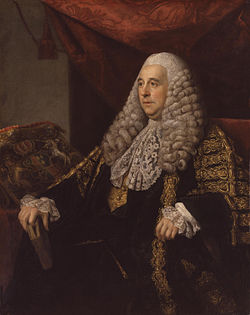Charles Pratt, 1st Earl Camden
|
The Right Honourable The Earl Camden PC |
|
|---|---|

Charles Pratt, 1st Earl Camden by Nathaniel Dance
|
|
| Lord Chancellor | |
|
In office 1766–1770 |
|
| Monarch | George III |
| Prime Minister |
The Earl of Chatham The Duke of Grafton |
| Preceded by | The Earl of Northington |
| Succeeded by | Charles Yorke |
| Lord President of the Council | |
|
In office 27 March 1782 – 2 April 1783 |
|
| Monarch | George III |
| Prime Minister |
The Marquess of Rockingham The Earl of Shelburne |
| Preceded by | The Earl Bathurst |
| Succeeded by | The Viscount Stormont |
|
In office 1 December 1784 – 18 April 1794 |
|
| Monarch | George III |
| Prime Minister | William Pitt the Younger |
| Preceded by | The Earl Gower |
| Succeeded by | The Earl Fitzwilliam |
| Personal details | |
| Born | before 21 March 1714 Kensington, London, England |
| Died | 18 April 1794 (aged 80) |
| Nationality | British |
| Alma mater | Kings College, Cambridge |
Charles Pratt, 1st Earl Camden, PC (baptised 21 March 1714 – 18 April 1794) was an English lawyer, judge and Whig politician who was first to hold the title of Earl of Camden. As a lawyer and judge he was a leading proponent of civil liberties, championing the rights of the jury, and limiting the powers of the State in leading cases such as Entick v Carrington.
He held the offices of Chief Justice of the Common Pleas, Attorney-General and Lord Chancellor, and was a confidant of Pitt the Elder, supporting Pitt in the controversies over John Wilkes and American independence. However, he clung to office himself, even when Pitt was out of power, serving in the cabinet for fifteen years and under five different prime ministers.
During his life, Pratt played a leading role in opposing perpetual copyright, resolving the regency crisis of 1788 and in championing Fox's Libel Bill. He started the development of the settlement that was later to become Camden Town in London.
...
Wikipedia
